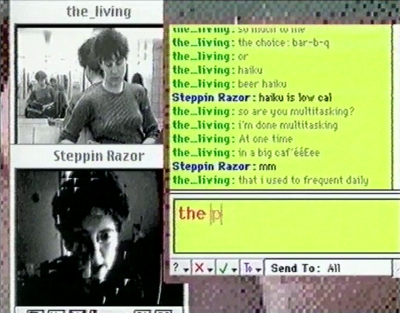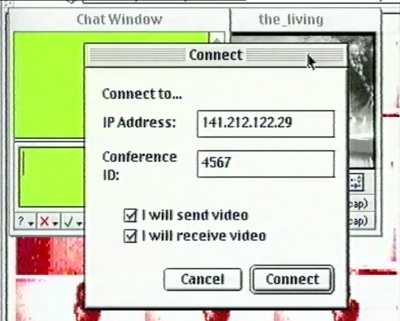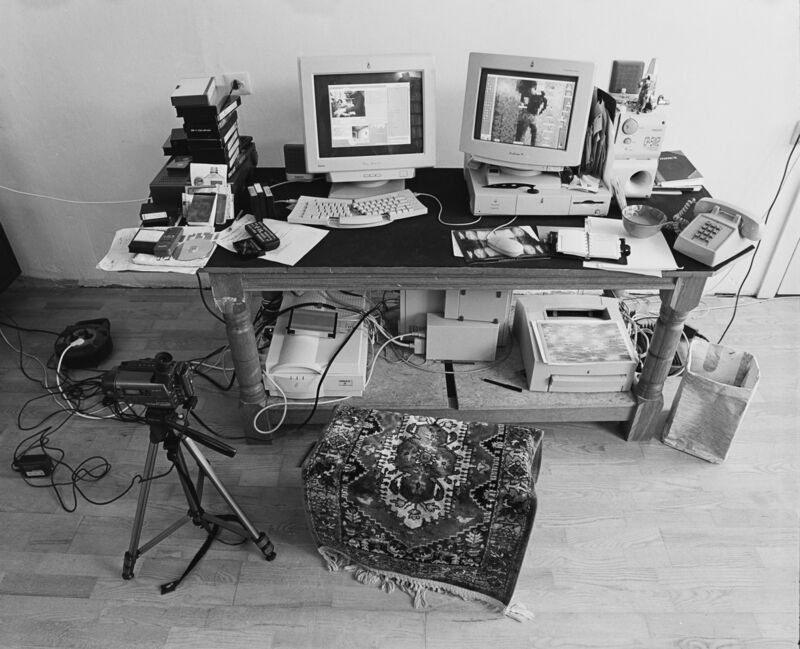The living
Work in progress
Contents
Introduction
This page presents the performance-based net artwork the_living (1997-1998) by artist Debra Solomon. In 2019, the_tiving was included in LI-MA’s Digital Canon project as part of twenty works that had lasting influence on digital art and culture in the Netherlands. In 2022, LI-MA carried out the research and conservation of the_living. The preservation team received the personal archive of Debra Solomon in Fall 2022, followed by an interview with the artist in early 2023. Rather than re-enacting the work in the original set-up, the artist and the preservation team agreed that activating the work with a critical reflection of its conceptual aspects is a better way of preserving the memory and legacy of the_living. The Wiki presentation contributes to this goal of critical research and reflection on the work, with publishing as a preservation strategy. The structure of this web presentation follows the model of another case study researched by LI-MA and by Dušan Barok, Naked on Pluto (2010-2013, Marloes de Valk, Aymeric Mansoux, Dave Griffiths). This web presentation is written by Haitian Ma, with input from Gaby Wijers, Joost Dofferhoff, Claudia Roeck, Olivia Brum, and the artist Debra Solomon.
Work
The_living is a performance-based net artwork carried out by artist Debra Solomon (US/NL) between 1997 and 1998. It centered around the online life of the digi-persona ‘the_living’, with the artist as her flesh holder. The work is highly situationist, with the_living intervening in different chat rooms of an early video conferencing software CU-SeeMe without former notice. There, she would chat with other online users and live streamed moments of her life in unusual places, such as swimming pools, in Amsterdam canals and on the bike. These live performances often last throughout the day. The_living also had a website www.the-living.org, where the artist gave explanations of the work and displayed the various ‘Tamagotchi gifts’ - animation and midi files she created for her audiences.
After the year-long performance, the_living project continued to evolve in the form of installations, broadcasts and in-person tours until a complete shift in the artist’s practice in 2003. The website is no longer online and most of the digital files have been lost. The ephemeral lifespan of the work, however, does not veil its pioneering thrust in staging artistic intervention into the online public space, and critically reflecting on the blurring boundaries between the physical and virtual worlds at the early Internet age.
Art Historical Context
Driven by the fascination with the Internet as a communication network, the popularization of cyberpunk as a genre, and renewed demands from the Third-wave feminist movements, the late 1990s saw the creation of digi-persona and avatars by female media/net artists in the Netherlands and abroad. They share common themes such as the exploration of online identities and the creation of imaginative narratives that entwined the physical, virtual and psychological realms of human existence.
Artist Practice
After graduating from the Gerrit Rietveld Academie audiovisual department, Debra Solomon started producing a few installation and web-based artworks that interrogated the borderline between the Internet and the physical space. This led to the creation of the_living project in 1997, anticipated by the artist as a year-long online performance. The work also took on a physical iteration between 1999 and 2000, where the artist went on a series of tours across the United States with expanded installations. In 2003, Solomon’s practice underwent a radical shift from the digital to the material sphere. She currently works in the field of food culture and multispecies urbanism, maintaining a fascination to working in public space settings.
Functionality and Concept
Situationist
What distinguishes the_living from other net art projects of the time lies in the ‘intervening’ gesture of her online performance. Without former notice, the digi-persona entered uninvited into different chatrooms (‘reflectors’) hosted by other users in the video conferencing software CU-SeeMe. This intervening and hijacking gesture made the work highly situationist, with the performance developing from the interaction and responses from her audiences. It also meant that audiences of the_living were often unaware that their interaction with the digi-persona constituted part of an art project. As the artist also mentioned, the_living’s presence often produced mixed reactions of confusion, surprise and occasional irritation for other users in the chatroom.
The video image of the_living is created by the artist who has taken it upon herself to lend her physical appearance and live moments to the digi-persona she creates. – Debra Solomon, from the archived website www.the-living.org.
Durational
Different from those performances that unfold in the form of a one-time spectacle, the performance of the_living was durational, with the artist often being online for up to 14 hours a day. “I wanted to produce an imaginary of this promise of what tech was going to be, but actually I'm the one who was the most caught up in it.”
Technological Optimism
The artwork manifested a considerable extent of technological optimism with the Internet medium. In the beginning of the project, the artist imagined the_living to embody 'the dream of total connectivity' that completely blurred the physical and the online world. With the_living, Solomon had hoped to experience the ‘future’ presented to her in the popularized science fiction and to create a seamless experience between the physical and the virtual.
Disillusionment & Departure
The reception of the artwork within the net art scene in the Netherlands varied. In the beginning of the project, the artwork received considerable media coverage and visibility in exhibitions. In 1998, the artwork was featured in the AVRO Digitale Diva's programme. Together with the two other works Nara Zoyd by Yvonne le Grand and Mouchette by Martine Neddam, the_living was considered one of the pivotal works reflecting on identities on the Internet. That said, most exhibition renderings of the artwork were unable to showcase the situationist and performative aspect of the work, and only presented a flat representation of the_living.
- 'The level of immersion you had to have to maintain relationships with people in these chat rooms wasn't replicable. So the_living in exhibition settings merely produced a representation of the artwork, and I think what I eventually started doing was showing moments from and/or just the desktop of my computer, with the ‘tamagotchi’ style animations and midi sound files of music, because it was too difficult.' - Debra Solomon.
Because of its performance set-up in online video chat rooms, the work had also been misunderstood and wrongly associated with cybersex and pornography, which the artist was completely unaware of, but also indirectly and negatively impacted by at the time. Due to the excessive labor devoted to arranging the technicalities and the time spent online, the_living also affected the well-being of the artist, who eventually shifted her artistic practice to right to the city political expressions of urban agriculture and food culture from 2003 onwards.
Components
Apart from the unique situationist aspect in the_living’s online performances, the work was also complex in operating across multiple platforms and softwares. Two main online manifestations of the performance were the CU-SeeMe platform and the website www.the-living.org. In addition, the work involved a long process of pre-production with the artist producing video footage of the_living, creating animation files and sounds to be displayed on the website, and archiving her chat and video interactions with the audience. The website presented two main audiovisual components of the work, ‘Wardrobe of Live Moments’ and ‘Tamagotchi Gifts.’
Wardrobe of Live Moments
As a performance-based net artwork, the_living is carried out on both the Internet and the video conferencing software CU-SeeMe. As the fleshholder of the_living, the artist Debra Solomon would film herself typing into a laptop at different locations and times of the day. These series of video footage were then transmitted to her work-station computer through a camera, and served as the live video stream of the digi-persona. Debra Solomon called the series of pre-recorded video footage ‘Wardrobe of Live Moments.’ A total of 15 scenarios have been identified so far:
[Block 2 - Images with Captions]
[Bulleted list item,
Bulleted list item,
On the train ride,
In the swimming pool,
On a Ferris Wheel in Amsterdam Dam,
On Boat tour in Amsterdam canals and Vinckeveen,
In the woods on a winter day,
In the Ice Cave in Linz,
At a ‘Brain Fart’ session in Linz,
On the bike ride,
In the Grey Chamber,
At Cafe de Kleppel in Amsterdam,
At the European Space Agency,
At Betone Silo in Amsterdam,
At the bathroom - imitating a scene of Louis Aragon’s Paris Peasant ,
At the Hairdressers]
[ a series of screenshots/snippets of videos can be added for the to-be-digitized tapes]
Tamagotchi Gifts
While streaming the video footage, the_living would chat with others in the CU-SeeMe reflector and send them the ‘Tamagotchi gifts’ she made, consisting of animations, gifs and midi music. The digital content often draws references from other online narratives, characters and cybercultural scenes, such as the WhirlGirl webcomic, the Idoru figure in William Gibson's bridge trilogy, and the digital pet Tamagochi.
- 'These cute, low-res animations are like little snacks or whole meals (for online users). When they get proper meals (through these animation gifts), they (everyone in the chatroom) can have an intelligent discussion on (something together).’ – Debra Solomon.
A handful of animation files and midi files have been identified during the literature and archival research. They are either adapted from available animations on other websites, or created from a pixelated version of the artist’s video recording of herself. The midi music files were gathered from online collections of popular Grunge and prog-rock. The following is a few found animation files from existing archival and documentation material:
[Block 4 - Images with Captions]
[Image of the dancing Idoru,
image of the Sugoi,
Image of the Kanji,
Image of the praying girl]
Conservation Measures
Artwork Condition
The website for the_living (www.living.org) is no longer online. The Internet Archive has preserved very limited interface content and GIFs. On 3 November 2022, two U-Matic tapes were borrowed from the V2_Lab for Unstable Media to LIMA, which offered a first impression of the visual appearance of the_living. On 25 November 2022, the artist Debra Solomon brought over a total of 90 items from her own archive to LIMA. These consist of 47 Hi8 tapes, 18 MiniDVs, 2 Super VHS, 6 removable cartridges, 16 analogue film slides. On 3 February 2023, the artist brought over another 55 items from her archive. These include 24 DVD CAMs and 31 Mini DVs. A total of 39 tapes have been identified as related to the ‘Wardrobe of Live Moments.’
Conservation Challenges
Because of the ephemeral and situationist nature of the piece, there was very little artist and audience documentation on the functionality of the work, making it difficult to understand the interaction and relationship between the components at the beginning stages of research. Fortunately, the interview with the artist Debra Solomon provided thorough insight into the conceptual and functional aspects of the_living. The first conservation strategy was to restore the work from a media-archaeological perspective. Part of the challenge for this strategy is the restoration of the initial technical set-up, from the disuse of the CU-SeeMe software, the lack of web pages captured in the Internet Archive, to the missing animation files and digital content.
But the bigger dilemma lies in the absence of a rapport for the video conferencing software and the performance itself. In the original artwork, the CU-SeeMe reflector not only served as a site to stage the artist’s performance, but also nested a community environment. With the disuse of the software but also the changing regulations of the online public space, such an openly accessible community of chatroom users do not exist anymore. Therefore, even if the software and other technological components were recreated, it is difficult to find a rapport for the_living’s performance that was situationist, namely without knowing their involvement in an artistic performance.
After gaining a more thorough understanding of the artwork, the preservation team decided that conservation of the_living will focus on spotlighting the situationist aspect of the artwork rather than restoring the original technical set up (see the following section ‘Activation at REBOOT 2023’).
Activation at REBOOT 2023
The_living has been included as part of the exhibition REBOOT, presented by Het Nieuwe Instituut and LI-MA. Pioneering digital art, REBOOT is an exhibition with key works from the period 1960-2000 and new work by contemporary makers. REBOOT presents the impact of digital technology in art and society is a collaboration between Nieuwe Instituut and LI-MA, and builds on the Digital Canon of the Netherlands, compiled by experts in 2017-2019 commissioned by LI-MA.
Instead of having a separate work station for the artwork, the presentation of the_living takes up an ‘intervening’ gesture as well. This manifests in the footage from 'Wardrobe of Live Moments' occupying the monitors of other artworks, any screen in the exhibition space, or other public spaces in and outside of the museum. As the visitors view and interact with other works, their viewing experience would be disrupted by the footage from the_living, thus restoring an element of surprise and contingency. This mode of presentation re-creates the situationist effect of the work in the exhibition space. It also adds a sense of agency and power in the presence of the digi-persona, which for various reasons was sidelined during the artist’s performance in 1997 and 1998.
[Image of the exhibition rendering at Het Nieuwe Instituut]
Publishing as a Preservation Strategy
To preserve the memory and art historical legacy of the artwork in the long run, the research into the artwork has led to the establishment of a long-term web presentation here on Monoskop that contextualizes the_Living. The web presentation allows the user to understand the work’s functionality and have an overview of its composing elements, such as the video footage 'Wardrobe of Live Moments' from the artist’s archive, documentation material of the website from the WayBack Machine and visual documentation of the hardware. For more theoretical discussion on publishing as a strategy of long-term preservation for time-based media art, see the article Publishing as a Strategy for Preserving Artistic Research written by Dušan Barok, Julie Boschat Thorez, Aymeric Mansoux for the artwork Naked on Pluto.
Archive
Documentation
Media Coverage and Exhibition Brochures
- Description of Debra Solomon's artwork "The Living." Originally published in "The Art of the Accident," DEAF 98, 1998. https://v2.nl/archive/articles/the-living. Accessed 1 February 2023.
- Debra Solomon, ‘The_living.’ DEAF 98, V2_Lab for Unstable Media archive, U-Matic tapes. Accessed November 2022.
- Avatar: of Postmodern Times and Multiple Identities, Paradox, 1998, https://www.paradox.nl/project/avatar/#exhibition, accessed 28 April 2023.
- µ (Mu), a fictional history of the Internet, Arti et Amicitiae, 1998, https://nettime.org/Lists-Archives/nettime-nl-9712/msg00001.html, accessed 28 April 2023.
- Debra Solomon, “the_living”, Gender, Media, Art, Next 5 Minutes III Conference, 1999, CD-ROM, LI-MA archive.
- Debra A. Solomon: the_living,' First Cyberfeminist International, hybrid workspace, Kassel, September 1997, 56-7.
- Ine Poppe, “Superworklurk Kan Snorkelend Typen; Debra Solomon Gaat Jaar on-Line Als Digitale Heldin.” NRC, NRC, 11 Dec. 1997.
- Ali Haselhoef, "Debra Solomon: The Living (1998)," Digitale Diva's, AVRO, December 1998, https://www.youtube.com/watch?v=Wdtqs9ttmxk.
- Dirk van Weelden and Jorinde Seijdel, 'Lizareebiekoe Ahobschkoh,' Mediamatic, 1 Jan 1998, https://www.mediamatic.net/en/page/8693/lizareebiekoe-ahobschkoh
- Michelle Teran, “Digital Persona.” Motherboard, https://www.liveart.org/motherboard/articles/99_mich_digital.html. Accessed 30 September 2022.
- ‘'the_living LIVE Episodic-broadcast in Video Conferencing Environment’, VIPER Media Art festival, Lucern, 1998, : https://web.archive.org/web/19991008001755/http://www.viper.ch/98/panorama/panoprese.html. Accessed 29 April 2023.
- “the_living. Debra Solomon.” Offenes Kulturhaus, Zentrum für Gegenwarts Kunst, description text, https://web.archive.org/web/19990427233244/http://www.ok-cca.aec.at/kurzpro.htm. Accessed 28 April 2023.
Artist documentation
- "Curriculum Vitae: D.A. Solomon." Archived by the Internet Archive 17 Jun 2000, https://web.archive.org/web/20000617055646/http:/www.xs4all.nl/~dsolomon/cvEN.html. Accessed 1 February 2023.
- Debra Solomon, "FAQ: The_Living Project." Archived by the Internet Archive 13 October 1999, https://web.archive.org/web/19991013123159/http://the-living.org/faq.html. Accessed 1 February 2023.
- “990914 the_living.” Betacam SP tape. call number 007, Artist archive. Accessed 1 December 2022.
Documentation of Artist’s practice and early works
- "The Egg of the Internet," project description, V2_Lab for Unstable Media, https://v2.nl/archive/works/the-egg-of-the-internet. Accessed 27 January 2023.
- Egg of Internet, image. Ars Electronica Archive, 1996, https://archive.aec.at/pic/showmode/4179/. Accessed 1 February 2023.
- Debra Solomon, Images (larger than) 1:1, web-based artwork. https://web.archive.org/web/20000607032517/http://desk.nl/~dsolomon/index.html Accessed 1 February 2023.
- Debra Solomon, "Images (larger than) 1:1." V2_Lab for Unstable Media Archive. https://v2.nl/archive/works/images-larger-than-1-1. Accessed 1 February 2023.
Artwork Components
- Videotapes from ‘Wardrobe of Live Moments’, 37 tape items (Hi8 & Mini DV), LI-MA archive, handed over by the artist.
- The website www.the-living.org (no longer online). Internet Archive link for www.the-living.org.
- Chat streams: two chat histories available from the Internet Archive capture of the website, https://web.archive.org/web/20010121231900/http://www.the-living.org/chat_archive/chatarch_1710.html. Accessed 28 April 2023.
- Animation files: available from the Internet Archive capture of the website, and the CD-ROM "Gender, Media, Art" (1998).
Research Documentation
- "Debra Solomon, the_living." Digital Canon, https://www.digitalcanon.nl/?artworks=debra-solomon#list. Accessed 1 February 2023; See also http://culiblog.org/ where Solomon's early public space-related work has been published.
- Boersma, Piete. Fotographer. “The Studio of Debra Solomon.” RKD, February 1999. https://rkd.nl/explore/images/293963, Accessed 12 January 2023.
- Artist interview transcript, conducted by Joost Dofferhoff, Haitian Ma, Sanneke Huisman, February 2023, LI-MA.
- Case study report: full report available upon consultation at LI-MA
- Case study summary: [link to LIMA website]


